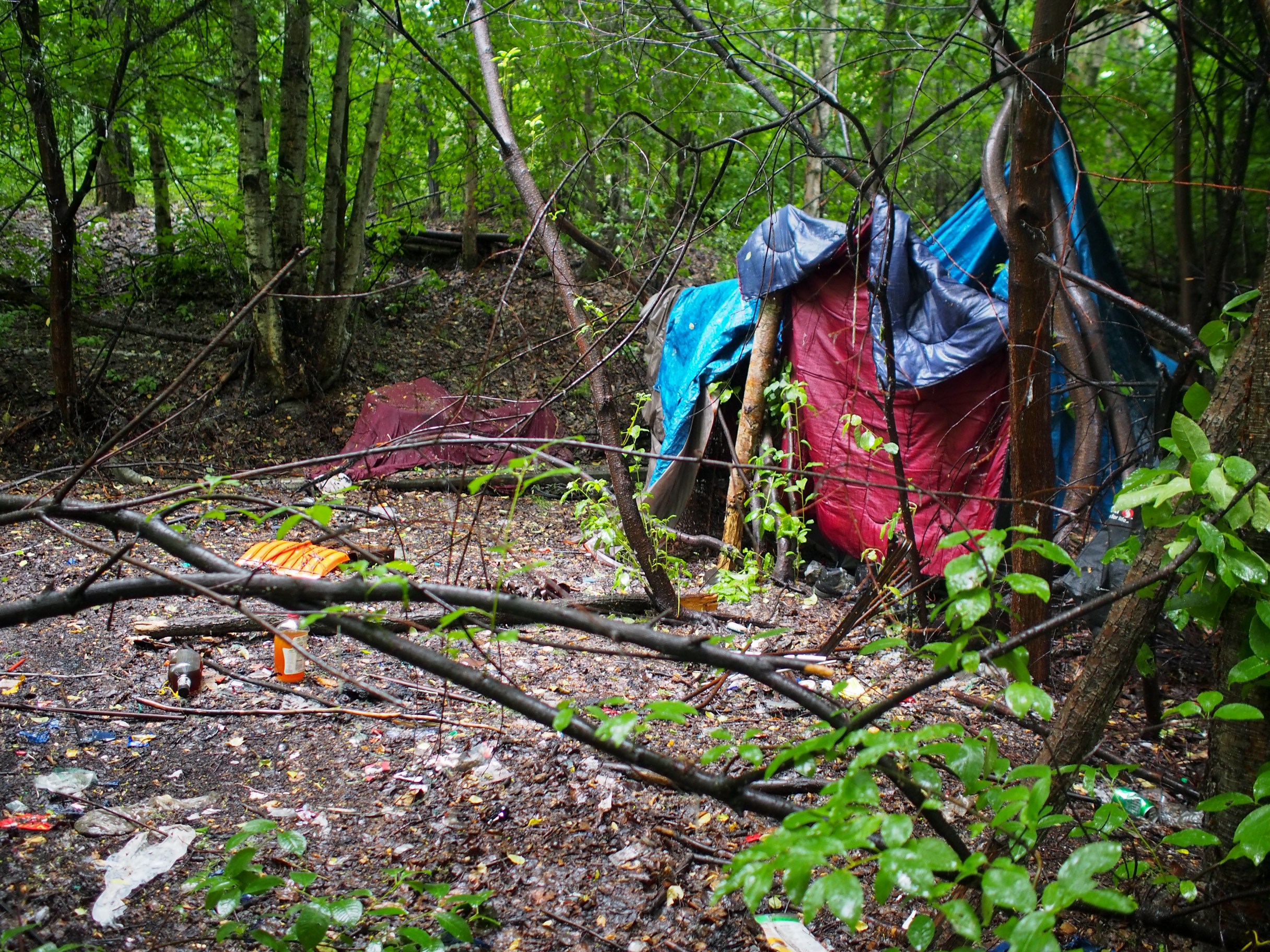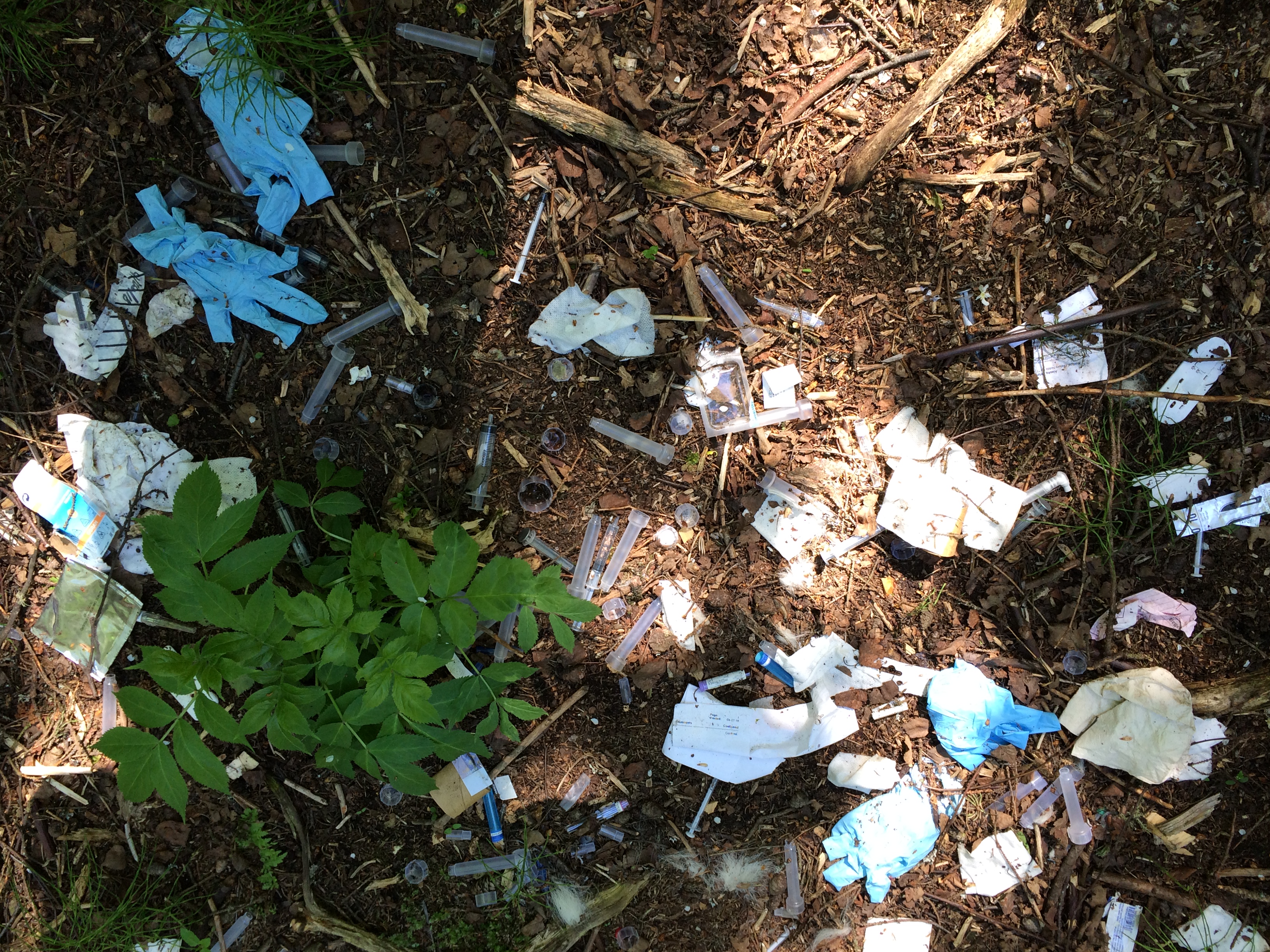
Anchorage officials are pushing forward with a new plan to more quickly clear away unlawful camps in the city’s parks and greenbelt.
Critics say homeless people in the camps are trashing the woods, committing crime and making the city’s public trails feel less safe.
Others say the encampments are one of the only options for people with nowhere else to go.
As rain trickled down on a recent morning, Anchorage Assembly member John Weddleton poked around in the woods, looking for things that aren’t supposed to be there.
Like an improvised fort tucked back in a thicket.
“Tarps over the sticks,” Weddleton observed, “and a tent inside.”
It was a small homeless camp, scraps of trash strewn about, along with alcohol and soda bottles.
The owner was either asleep or away.
Weddleton represents communities in the southern part of the municipality.
He is keenly interested in one of the body’s most persistent and hotly contested questions: what to do about people setting up unlawful encampments throughout public green spaces.
As civic consternation has grown more intense, with increasingly vocal community groups pressing officials to act, the Assembly has budgeted more funds for cleaning up abandoned camps.
Assembly members recently passed a measure speeding up the timeline for disassembling encampments that are close to trails, ball fields, schools and other public recreation facilities.
The details of that change still are being worked out, and it remains to be seen what difference it will make.
Weddleton followed trodden footpaths that resemble game trails winding through the woods near Chester Creek.
The area feels remote, but in fact, just past a small knoll is an apartment complex.
“One thing that’s so offensive about these is they’re scary because they’re so trashed,” Weddleton said. “It’s just disgusting, I mean they’re hazmat sites.”
About 1,100 homeless people live in Anchorage on a given day, according to the city Homelessness Coordinator Nancy Burke.
A portion of them stay in improvised shelters and encampments throughout the city’s sprawling green belt.
Many of those most familiar with the camps say they can be extremely dangerous to occupants’ health and safety.
Weddleton strikes up a conversation with a woman dressed all in black passing in the opposite direction, and asks if she feels unsafe walking along the trails given all the camps.
“No, I’ve lived in these camps for three years,” Toni Anaruk said. “These woods are crazy. Everybody lately, honestly, has been getting out.”
The area feels scarier, more dangerous, Anaruk said. There are heroin deaths. Bear encounters have sent people looking for camp spots further away. And there is violence. Two years ago, Anaruk was brutally attacked.
“I was chopped up in Valley of the Moon,” Anaruk said.
An Anchorage Daily News August 2016 article described an unnamed woman attacked with a machete in the same area by a 19-year-old acquaintance she accused of stealing from her.
Anaruk was the woman.
She pulled down the edge of her shirt by her shoulder to show Weddleton a thick red scar running all the way across her back.
“Holy smokes,” Weddleton gasped.
“That’s just one of six, the other one’s right here on my neck,” Anaruk ticked off. “Across my head, right here, my hand.”
The young woman did not stick around to answer other questions.

A section of the Chester Creek Trail nearby tends to be the most densely filled with encampments.
Earlier in the week, cleanup crews from the city’s Parks and Recreation Department had cleared away most of the tents, tarps and abandoned garbage.
Abating camps this way is one of the city’s main approaches to managing homelessness: telling individuals their camps are unlawful, then returning 10 days later to dismantle and clear anything left.
“We cleaned out over there, all the way to Gambell,” Greg Jacobsen said, referring to a swath of land behind the Ben Boeke Ice Rink to the arterial highway where Ingra and Gambell streets merge.
Jacobson has overseen municipal camp cleanup efforts for years.
He showed off raw patches of dirt not far off the paved trail where trees have been stripped out for fire wood or shelter.
Mounds of black trash bags await to be hauled out, filled with “lots of clothes brought in, bike parts, needles.”
Simply managing all the tremendous volume of waste generated by the encampments is a significant part of abatement.
The municipality had removed 92 tons of garbage since the start of the year, said Parks and Rec director John Rodda.
A lot of the trash is hazardous to health and safety: Hundreds of propane tanks, food scraps that invite bears and piles of human excrement that seep into the nearby waterways.
Sriticism says this strategy is fundamentally flawed, that it basically pays city employees to shuffle homeless people around.
Jacobson touched on this sentiment as he surveyed a site that crew members were almost finished cleaning.
“Because it’s all cleared out like this, somebody’s gonna move back in real quick,” Jacobson said with a hint of resignation. “We’re house-keeping.”
The Anchorage mayor’s administration is adamant that dealing with camps is one piece in a larger, long-term approach to getting people off of the streets, into housing and connected with supportive resources.
Social workers piggy back on the abatement process to make contact with individuals that can be tricky to otherwise find, gathering data in the process, according to Anchorage homelessness coordinator Nancy Burke.
“We’ve been using the camp ordinance and the processes that go around that as an organizing principal for outreach, basically,” Burke said.
Burke concedes that many residents are frustrated with a camping situation that appears to them to have worsened.
But Burke, as well as others from the administration and assembly, say that more individuals — many with severe mental health and substance abuse problems — have gotten off the streets as a result of policies expanding housing opportunities.
“The visual doesn’t always match the progress,” Burke said, adding that according to her office’s data, homelessness in the municipality overall is trending downward. “But the residents are not feeling that, and so what I need to make sure I’m doing is helping them understand the long-term play. It is a very complex system.”
Even with an overarching strategy for addressing homelessness, sympathetic critics feel the current policies toward camps are unacceptable.
A former board chair of the Alaska Mental Health Trust Authority, Russ Webb spent decades with the State of Alaska working on issues connected to substance abuse and mental health.
He regularly takes photos of sprawling encampments along the trails near his neighborhood to report for cleanup.
“That kind of squalor is unsafe for the people camping there, and certainly for the people using those public green spaces. Including kids,” Webb said.
The population camping along the trails is heterogeneous, according to Webb, and he is quick to give credit to recent progress moving many of the city’s most vulnerable into better shelter situations.
But people live on the streets for lots of different reasons.
In Webb’s experience the administration’s current tools have no recourse for dealing with folks with no interest in housing.
He believes the policy focus on long-term solutions has in the meantime created “passive acceptance” of what’s happening now.
“What we haven’t done is focus on the campers who are young, capable, involved in criminal activities and victimizing others,” Webb said. “Other campers, as well as others in the community.”
Webb believes an approach to homelessness needs long-term plans and reactive safety concerns on the other.
